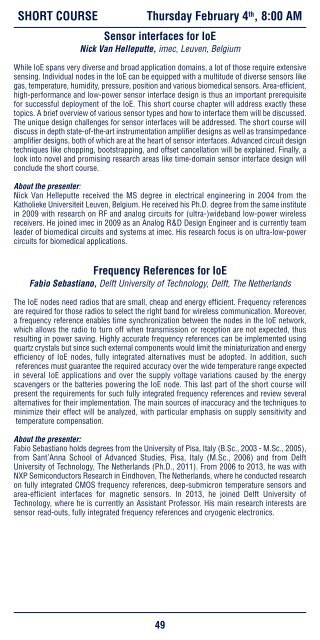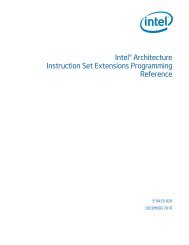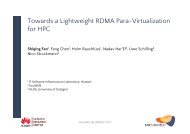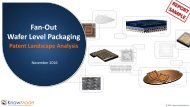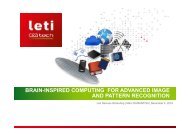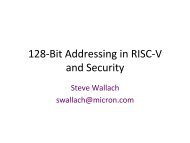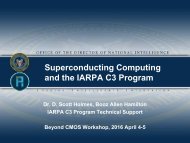You also want an ePaper? Increase the reach of your titles
YUMPU automatically turns print PDFs into web optimized ePapers that Google loves.
SHORT COURSE<br />
Thursday February 4 th , 8:00 AM<br />
Sensor interfaces for IoE<br />
Nick Van Helleputte, imec, Leuven, Belgium<br />
While IoE spans very diverse and broad application domains, a lot of those require extensive<br />
sensing. Individual nodes in the IoE can be equipped with a multitude of diverse sensors like<br />
gas, temperature, humidity, pressure, position and various biomedical sensors. Area-efficient,<br />
high-performance and low-power sensor interface design is thus an important prerequisite<br />
for successful deployment of the IoE. This short course chapter will address exactly these<br />
topics. A brief overview of various sensor types and how to interface them will be discussed.<br />
The unique design challenges for sensor interfaces will be addressed. The short course will<br />
discuss in depth state-of-the-art instrumentation amplifier designs as well as transimpedance<br />
amplifier designs, both of which are at the heart of sensor interfaces. Advanced circuit design<br />
techniques like chopping, bootstrapping, and offset cancellation will be explained. Finally, a<br />
look into novel and promising research areas like time-domain sensor interface design will<br />
conclude the short course.<br />
About the presenter:<br />
Nick Van Helleputte received the MS degree in electrical engineering in 2004 from the<br />
Katholieke Universiteit Leuven, Belgium. He received his Ph.D. degree from the same institute<br />
in 2009 with research on RF and analog circuits for (ultra-)wideband low-power wireless<br />
receivers. He joined imec in 2009 as an Analog R&D Design Engineer and is currently team<br />
leader of biomedical circuits and systems at imec. His research focus is on ultra-low-power<br />
circuits for biomedical applications.<br />
Frequency References for IoE<br />
Fabio Sebastiano, Delft University of Technology, Delft, The Netherlands<br />
The IoE nodes need radios that are small, cheap and energy efficient. Frequency references<br />
are required for those radios to select the right band for wireless communication. Moreover,<br />
a frequency reference enables time synchronization between the nodes in the IoE network,<br />
which allows the radio to turn off when transmission or reception are not expected, thus<br />
resulting in power saving. Highly accurate frequency references can be implemented using<br />
quartz crystals but since such external components would limit the miniaturization and energy<br />
efficiency of IoE nodes, fully integrated alternatives must be adopted. In addition, such<br />
references must guarantee the required accuracy over the wide temperature range expected<br />
in several IoE applications and over the supply voltage variations caused by the energy<br />
scavengers or the batteries powering the IoE node. This last part of the short course will<br />
present the requirements for such fully integrated frequency references and review several<br />
alternatives for their implementation. The main sources of inaccuracy and the techniques to<br />
minimize their effect will be analyzed, with particular emphasis on supply sensitivity and<br />
temperature compensation.<br />
About the presenter:<br />
Fabio Sebastiano holds degrees from the University of Pisa, Italy (B.Sc., 2003 - M.Sc., 2005),<br />
from Sant’Anna School of Advanced Studies, Pisa, Italy (M.Sc., 2006) and from Delft<br />
University of Technology, The Netherlands (Ph.D., 2011). From 2006 to 2013, he was with<br />
NXP Semiconductors Research in Eindhoven, The Netherlands, where he conducted research<br />
on fully integrated CMOS frequency references, deep-submicron temperature sensors and<br />
area-efficient interfaces for magnetic sensors. In 2013, he joined Delft University of<br />
Technology, where he is currently an Assistant Professor. His main research interests are<br />
sensor read-outs, fully integrated frequency references and cryogenic electronics.<br />
49


